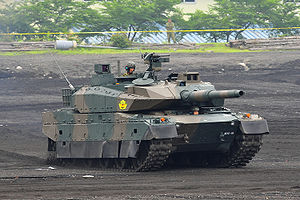Type 10 (tank)
| Type 10 | |
|---|---|

Type 10 prototype |
|
| General properties | |
| crew | 3 (commander, driver, gunner) |
| length | 9.42 m (with pipe) |
| width | 3.24 m |
| height | 2.30 m |
| Dimensions | 44.0 tons |
| Armor and armament | |
| Armor |
Composite armor spaced armor |
| Main armament | 120 mm smoothbore cannon |
| Secondary armament | 12.7mm machine gun Browning M2 7.62mm coaxial machine gun |
| agility | |
| drive | 8-cylinder diesel 880 kW (1200 PS) |
| suspension | hydropneumatic |
| Top speed | 70 km / h (road) |
| Power / weight | 20.1 kW / t (27.3 PS / t) |
The Type 10 is a main battle tank of the Japanese Ground Self-Defense Forces . The tank, formerly known as TK-X or MBT-X , is intended to replace the Type 74 tanks and complement the Type 90 . Development began at the end of the 1990s and production started in 2010. On February 13, 2008, the Japanese Technical Research and Development Institute (TRDI) presented the prototype to the public. The focus of the design was on improved capabilities in the areas of C4I and mobility as well as good all-round protection.
description
The TRDI in Sagamihara published pictures of the vehicle from the outside and the interior. While the Type 90 is mainly tailored to the geographical conditions of Hokkaidō , since an invasion of the Red Army was expected there, the Type 10 should be able to be used on the entire Japanese mainland. During the construction, care was taken to use as many existing parts and systems as possible ( COTS ), including the possibility of transport on civilian semi-trailers . Low life cycle costs were also a target.
The design of the Type 10 was adopted in December 2009. The unit price is 954 million yen (8.9 million euros) per tank, including development costs. 13 pieces have been ordered every year since 2010, 14 pieces in 2013. A total of 68 tanks are planned to be purchased by the 2015 budget year.
technology
protection
The Type 10 is primarily designed for asymmetrical warfare . Special attention was paid to good all-round protection instead of strong front armor. The vehicle has modern composite armor with ceramic and carbon fiber and weighs 40 tons in this basic configuration. This means that it can be transported with civilian semi-trailers, which saves costs. In battle, the armor is supplemented by spaced armor , which gives the vehicle its characteristic appearance. This increases the weight to 44 tons. The maximum weight of the Type 10 is 48 tons, which contains a weight reserve for possible additional armor in the future. The armor has a modular structure so that individual parts can be replaced if damaged.
The tank has laser detectors, infrared sensors (possibly rocket detectors) and radar detectors in MEMS technology, which are coupled to the smoke launch system and cover 360 °.
mobility
The tank is powered by a water-cooled, turbocharged V8 diesel engine (possibly with adjustable turbine guide vanes ). With 880 kW and a specific output of over 20 kW / t, the vehicle is relatively heavily motorized for its weight and has advantages in terms of fuel consumption due to the small engine. The use of a continuously variable transmission makes it possible to accelerate without delay. The engine control lets the engine work in a favorable speed range while cruising , the speed is controlled via the gearbox (fuel saving). When the power requirement is high, the engine delivers maximum torque, with the hydromechanical transmission transmitting the highest possible torque to the chains in order to achieve high accelerations. The vehicle has five castors on each side and hydropneumatic suspension . This makes it possible to control each roller individually, which allows the tank to tilt in almost any direction. This ability to precisely in the ride in difficult terrain and the sighting in difficult situations target position Häuserkampf improve. The press present was not allowed to view the interior of the tank, only photos of the rifle and commanders' area were published.
Firepower
The Type 10 is equipped with a 120 mm smoothbore cannon L / 44 with a car loader in the turret rear. The autoloader holds 14 rounds, additional ammunition is stored in the tub. This weapon is developed domestically, but the ammunition is compatible with the Rheinmetall product . New APFSDS projectiles are to be developed for the cannon . As Koaxialwaffe one's machine gun caliber 7.62 x 51 mm NATO built, is still on the tower roof, a remote-controlled Browning M2 . The commander's periscope sits on a kind of "tower" to improve all-round visibility.
C4I
In accordance with the NCW doctrine, the tank can be networked with other units on the battlefield in order to exchange data. The system will later be extended to other vehicles, infantrymen and aircraft ( Kawasaki OH-1 , Boeing AH-64D ).
Web links
- TRDI (Japanese)
- photos
- Video on Youtube
- military-today
swell
- ↑ a b c d http://www.military-today.com/tanks/tk_x.htm
- ↑ Japan's Defense Budget 2010 (PDF; 2.9 MB)
- ↑ Kantei : 中期 防衛 力 整 備 計画 (平 成 23 年度 〜 平 成 27 年度) に つ い て
- ↑ a b https://www.youtube.com/watch?v=ffNiosiPlxY&fmt=18&annotation_id=annotation_558709&feature=iv
- ^ Ministry of Defense : Current state of defense industry by sector . 2012. Accessed in 2018/02/12.
- ^ Taisei Ugaki: Published new tank prototype vehicle . In: Japan Military Review . 43, No. 4, April 2008, pp. 28-35.
- ↑ Archive link ( Memento from February 25, 2008 in the Internet Archive )